Tamarindo to San Ramon
The bus trip from Tamarindo to San Ramon was uneventful. Since there is no bus station in Tamarindo, we didn’t have reserved seats, we just sat in the first two empty seats (at the very front of the bus, since Ann has a tendency to get motion sickness). The bus driver told us (in very rapid Spanish) that if someone boarded with those reserved seats we would have to move (at least that’s what we think he said). At every stop, we got ready to move but we never had to. The bus ride took 4 ½ hours with a bathroom and snack break about halfway along. Long distance buses in Costa Rica are nice and are a lot cheaper than tourist shuttles or taxis. It just takes a little work figuring out the routes. Even with our taxi expenses, we have saved a gob of money over renting a car or taking shuttles everywhere. Shuttles are priced for the tourist market, buses are priced for the locals, one of the clearest examples of location arbitrage we’ve seen. While a bus might cost $9 each, a shuttle could cost $55 each and instead of being in a plush motor coach with comfortable seats, we would be cramped (as the shuttles are often shared) into a van. Our advice: take a long distance bus whenever possible in Costa Rica.
Our Airbnb and Hosts
Our Airbnb hosts, Nancy and Andy, offered to pick us up once we arrived in San Ramon, which worked out great. Andy gave us an introduction to downtown San Ramon and took us to shop for groceries. We then went to the property and were shown around the apartment. Wow! The main house is 4700 sq ft with a lap pool in the living room and a bridge over the pool. They have three Airbnb listings: an 1800 sq ft casita, the 1000 sq ft apartment in which we are staying, and a smaller (but not that small) back apartment, all part of what they call Hacienda Vivace. Being the first people to stay in the apartment, a few kinks are still being worked out but it’s been fine.
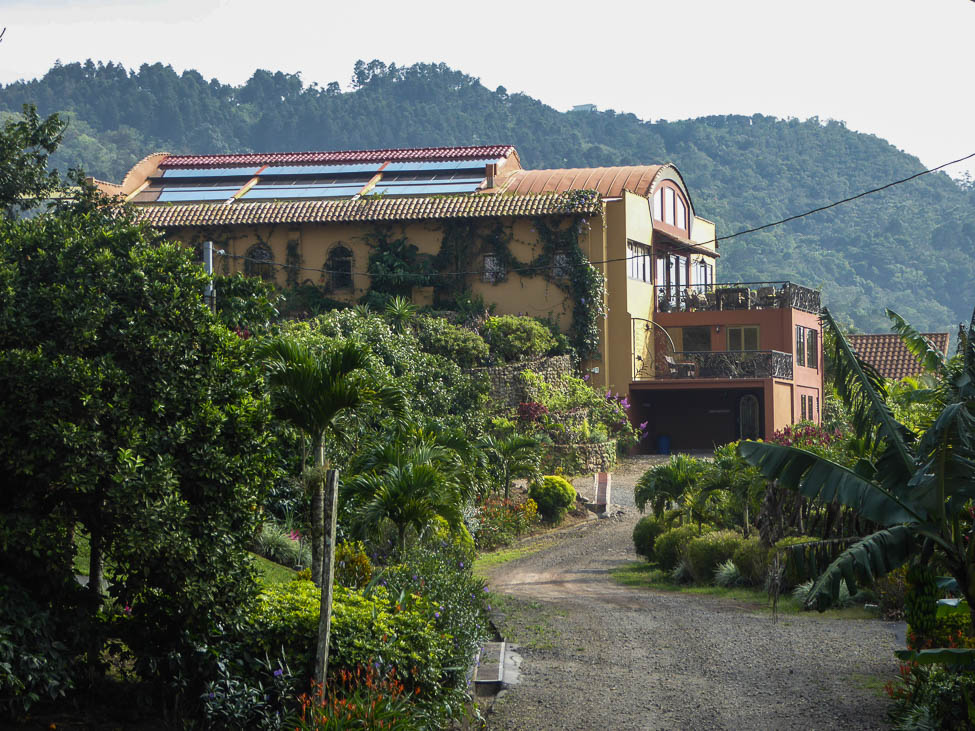




Clouds move in and out all the time, and we are enjoying just sitting on the massive patio, drinking a glass of wine and watching them.

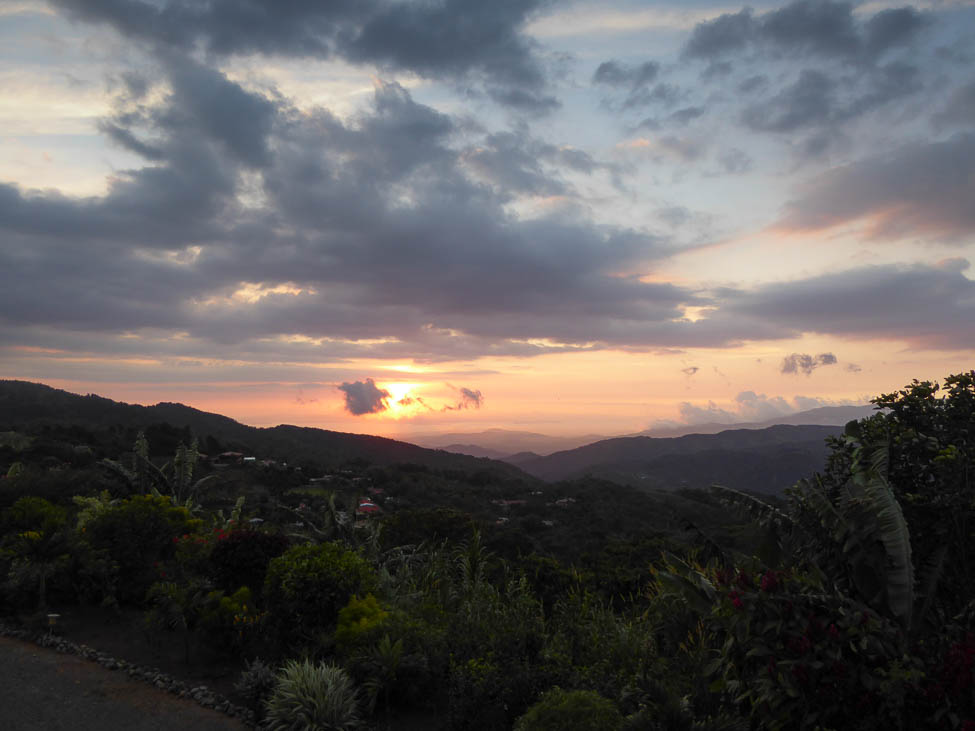
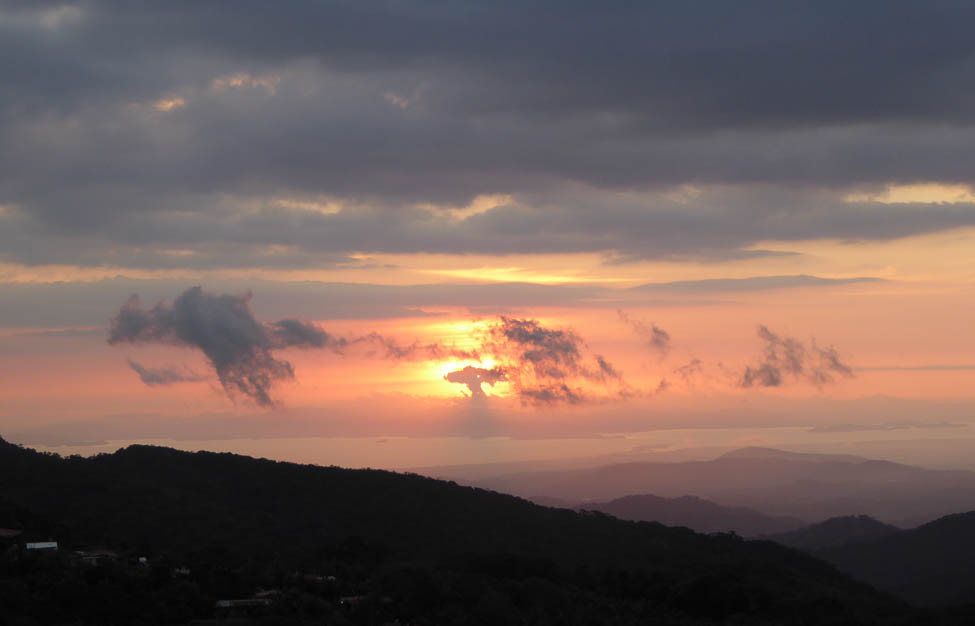
The only downside: we are a little isolated. Anytime Andy is going into town, he offers us a ride, and we usually end up taking a taxi back for about $6. If we want to go out by ourselves, it’s a 20 minute walk to the bus stop, then $.40 each to town. Both times we’ve walked to the bus stop, we’ve been picked up, once by Andy and once by a collectivo taxi that we didn’t realize was one until Ian saw the driver take the sign down after two young ladies got in the back seat with Ann. It was a great ride (stopping for gas along the way), the driver was a character, who had spent three months in North Dakota on a farm without speaking much English. He kept whipping out his phone and mimicking how great Google Translate was. At $1 for the two of us, it was an entertaining bargain. However, we haven’t yet taken the bus back from town since it’s a little trickier without taking it into town and seeing what route we need. We stopped by the bus station in town the other day, and there were at least half a dozen buses ready to leave and many people waiting to board other buses that hadn’t yet arrived.
Our Latest Snafu
When we were getting immunizations before leaving San Diego, the controversial one was yellow fever. Ian was told that it’s not recommended for people over 60 unless they are going to an area with an active outbreak. It’s a live, weakened virus, and people over 60 are more likely to develop adverse reactions and/or the disease itself from the vaccine than younger people are. Kaiser was going to give it to Ann knowing her health history. The issue is that some countries won’t let you in without the shot. After much discussion and looking at our itinerary, it looked like the shot was not necessary so we didn’t want to take the risk. Then last month, we changed our plans, adding Panama. Last week, we discovered that Panama is an affected country, so unless we had a layover in Panama of less than 12 hours, Colombia wouldn’t let us in. We were planning on doing a land crossing into Panama and spending about 12 days there. What to do: change our plans again by flying to Panama the same morning we were flying to Colombia, cancel Colombia (not happening), get the shot. After doing a lot more research, we decided to get the shot. Next, we had to figure out how to do that. Turns out in Costa Rica shots are given in a pharmacy, so that’s what we did in San Ramon (all in Spanish) and then we had to take the pharmacists’ forms, the vaccine’s boxes, and the empty syringes to the Ministry of Health (again all in Spanish) so that we could get our yellow fever certificates. (The young woman who assisted us at the health office questioned why the empty syringes were in the boxes.) Because of the virus’s incubation period, we decided to extend our stay in San Ramon by an additional four days – it helps that our apartment is great! That way if anything happens, we are in a town with a hospital and within one hour, we can be in San Jose with excellent hospitals. So far no reaction, keeping our fingers crossed.
Exploring San Ramon
Our Airbnb host, Andy, gave us a more detailed walking tour around San Ramon when he took us to get our shots on Thursday. There are about 300 gringos (we’ve heard higher estimates – can’t really be sure of the exact number because some people come and go and others are part-time) living in the area around San Ramon, of which about half are reportedly recluses. The population of the city of San Ramon is about 11,000, about 85,000 people when you include the areas surrounding the city, so it’s still very much a Tico town. When we’ve been walking around on our own, it’s rare to see a tourist or expat, much different than at the beaches.
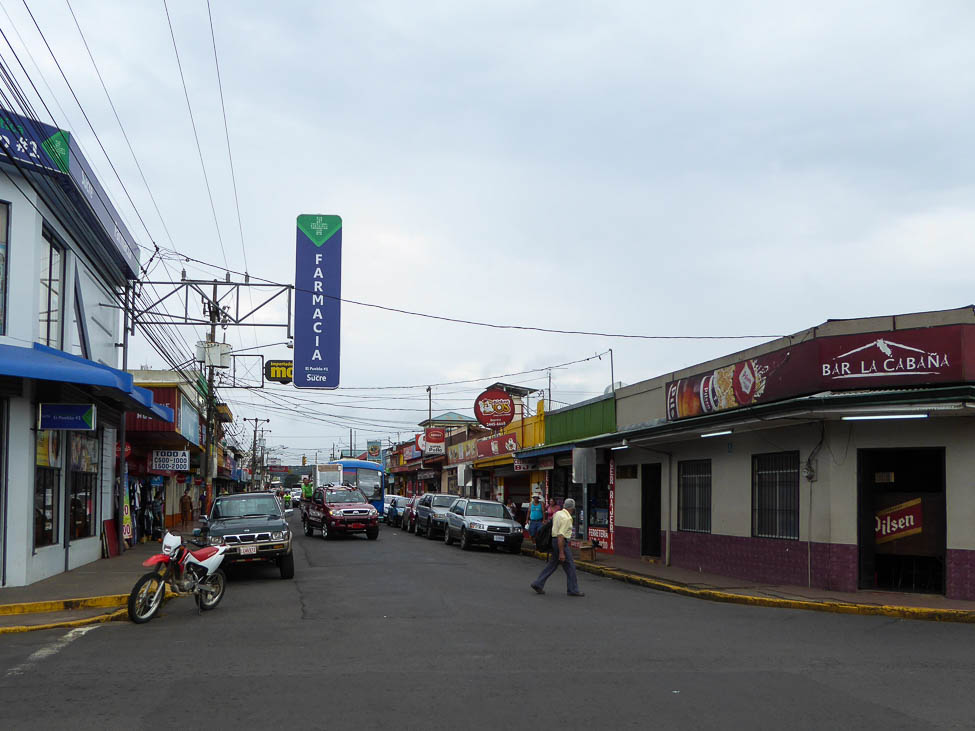
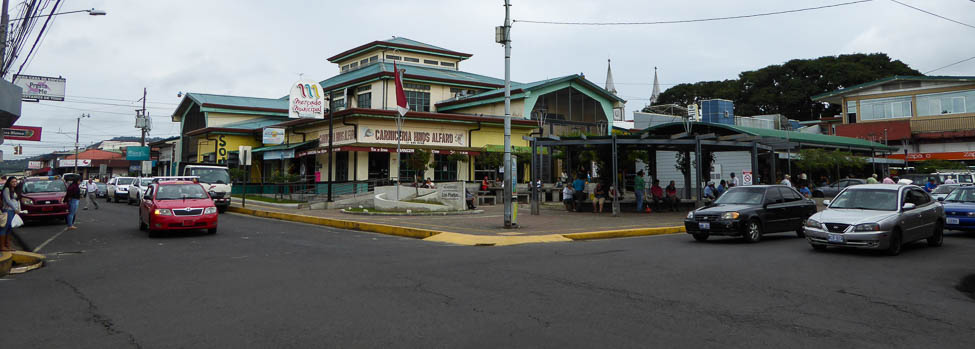
Thursday night, we were invited to the monthly mixer of the Community Action Alliance (CAA) , a volunteer organization of expats and Costa Ricans. We met about 20 expats, all of whom seem very happy with their decision to move here, whether full- or part-time. How fortuitous that their monthly get together just happened to be while we were here!
On Friday, we went to the farmers market, feria, which is held Fridays from 1-7 pm and Saturdays from 9 am-3 pm. It’s quite large, maybe a couple hundred vendors. Even though most are selling the same fruits and vegetables, it’s well worth a visit.
We went into town a few other times by ourselves. San Ramon is a comfortable town in which to wander around and we have always felt safe. On Sunday, we spent some time in the central park, across from the main church (as is the case in many Latin American cities), watching the world go by. The park has a great kids play area, including equipment for special-needs children. An older gentleman sitting near us was playing guitar and singing quietly for a few friends as they came by. We could have done without the preacher and his boom box in the middle of the park, but most Ticos seemed to just ignore him, so we tried to do the same. As the Catholic church let out, the number of people in the park swelled and there was a bit of a traffic jam on the main road as people just double parked, waiting to pick people up.

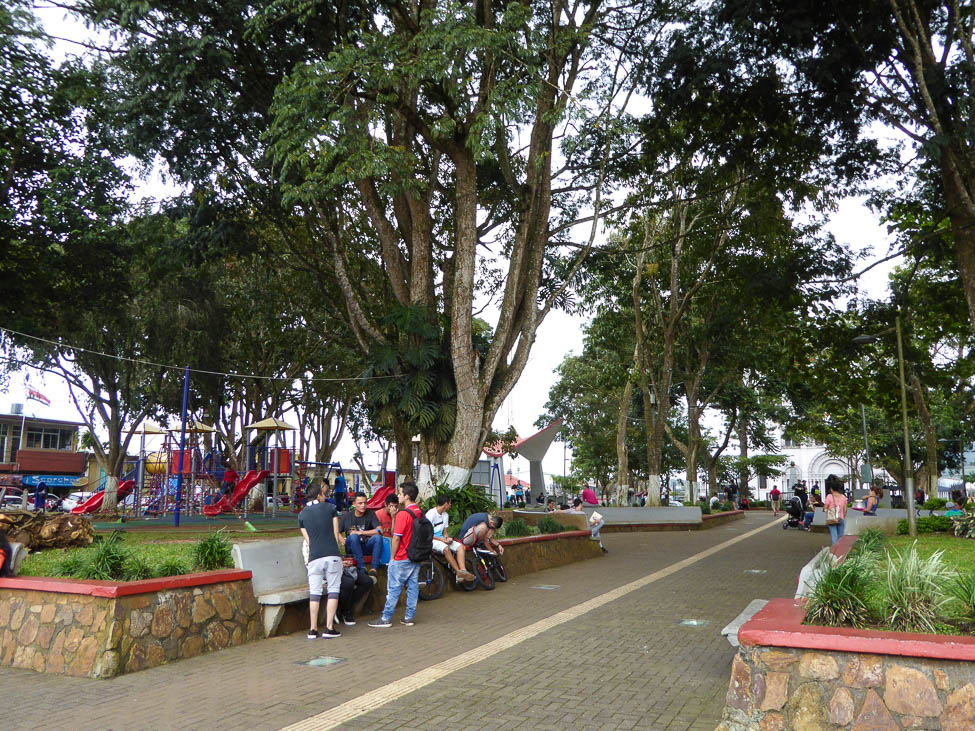
How are prices?
San Ramon has four large grocery stores, two produce markets, the farmers market, many small grocery stores, and very few tourists, so we’ve noticed a drop in prices. At the farmers market and produce markets, fruits and vegetables are quite reasonable: a head of lettuce cost us $.50, same with tomatoes, and cucumbers. We can get pineapples for $1-2, same with papayas and mangoes. Of the locally grown produce, only avocados are a little pricey. One item that we’ve found pricey in all three places we’ve been in Costa Rica is yogurt; it’s been hard to find plain yogurt and forget about Greek yogurt – a small container enough for two+ breakfasts is $3. Milk is $2 for a half gallon. Cream cheese is $2, and Ian’s found a local brand, Dos Pinos, that he likes so much better than Philadelphia. We’ve found a local cheese, Turrialba, that tastes like mozzarella for $3 a pound, and cold cuts are as low as $6 a pound. At the most gringo market, rotisserie chicken is $7.50 and quite good, though smaller than Costco’s. One surprise is that we’ve been able to find Chilean wine that’s quite drinkable for $7 per bottle. At a bakery, we got empanadas for $1 each and made lunch out of them one day. We picked up a tasty large loaf of pineapple bread for $2 and a baguette for $1. We got ice cream cones for $.75 each. One bit of info we forgot to mention in our last post: many places, especially in Tamarindo, including restaurants and larger grocery stores, accept US dollars; many of the restaurants in Tamarindo list their menu prices in dollars.
Climate
The climate has two seasons: wet and dry. During the rainy season, it will usually rain for a couple of hours a day, but it is humid. During the dry season, the humidity goes down. All year long, the highs are going to be from about 70 to low 80’s and 50-60’s (Fahrenheit) at night. Now, at the end of the rainy season, to us the weather feels very similar to San Diego; there’s a cool breeze most of the time but instead of the ocean, it’s caused by the altitude. The only problem might be the dampness; we’ve been told that mold grows quickly here. Days are about 12 hours daylight and 12 hours dark all year round. When the sun starts to set, it sets quickly and the temperature drops rapidly. We also found out that we could be at the beach in 45 minutes by car.
We both agree that we could spend serious time in San Ramon. Perhaps we’ve found a possible expat location for at least part of the year. Nice weather, reasonable costs, close to the beach, without having to put up with the hot weather or the electricity bills. Perhaps a minor issue that could be overlooked is the amazing variety of bugs that keep showing up around the inside of the apartment. Ian’s still a little unsure about the rainy season, but he doesn’t have any of the first world guilt that he had in Guatemala; the Ticos seem to be able to afford a reasonable life, some even travel.
A Possibility?
Our next post will be about a visit to the Los Angeles Cloud Forest, two other towns within Costa Rica’s Central Valley that are home to expats, and a wrap up of San Ramon and the Central Valley.
When we leave San Ramon, we are going to spend four days in Quepos next to Manual Antonio National Park before crossing over into Panama.
Ian & Ann

10 Comments
Another enjoyable read. Love the name Tamarindo – has a ring to it. You are giving quite a explore to Costa Rico. Makes me want to visit it also.
Yes, Costa Rica has really impressed us, think you too would like it. When you’re ready, we’ll be happy to help you plan your trip.
Ian & Ann
Thanks for all the research. Art and I went to Costa Rica in the 80’s when we were dating and took his parents! We were impressed at that time with the country as it is a long standing democracy and it hasn’t had an army for many many years.
Quepos and Manuel Antonio were wonderful. Accessible rainforests that hopefully aren’t being exploited.
Thanks again for the updates.
Hi Sharona,
Yes, we are looking forward to visiting Quepos and Manuel Antonio next week. Our research has told us that the number of daily visitors to the park are limited, and the park is closed on Mondays to give nature a rest.
Ian % Ann
Cuando estaba en Costa Rica, bebía principalmente guarro, a diez centavos por vaso pequeño, a menos que lo mezclara con jugo de fruta o refresco. Es un tipo de ron local, creo. San Ramón es Costa Rica como a mí me gusta recordarlo: ni caliente ni frío y cómodo en casi todos los aspectos.
Hola Art,
Una botella de guarro cuesta 3400 colones ahora. Eramos un poco triste esta manana cuando nos fuimos de San Ramon.
Ian & Ann
Your blog is so interesting. What a wealth of information!
Hi Ellie,
We try. Please let us know if you have any specific questions or if there is other info you’d like us to include.
Ian & Ann
I loved the beach at Manuel Antonio – also the monkeys in the trees
We are planning on going there on Tuesday. I’m sure we’ll have some photos in an upcoming blog post, but probably some photos sooner on our Expatornot Facebook page.
Ian & Ann